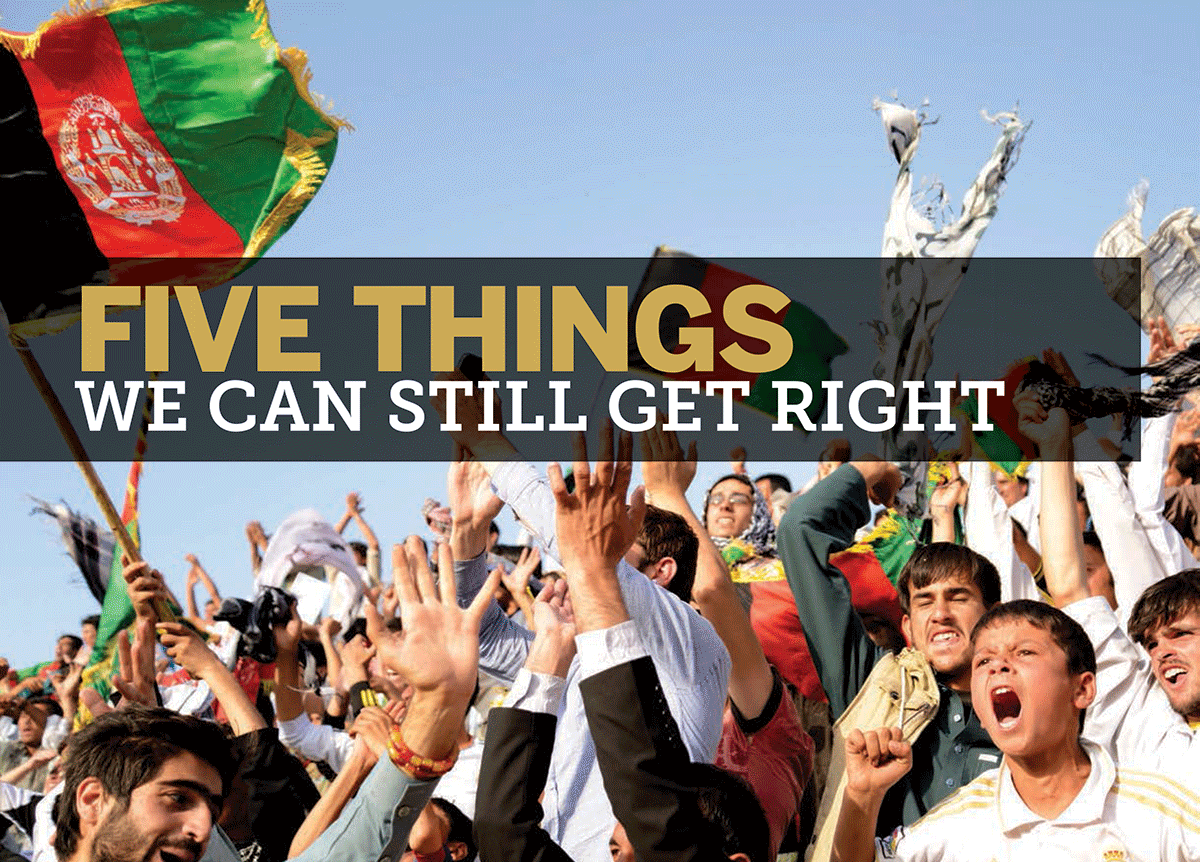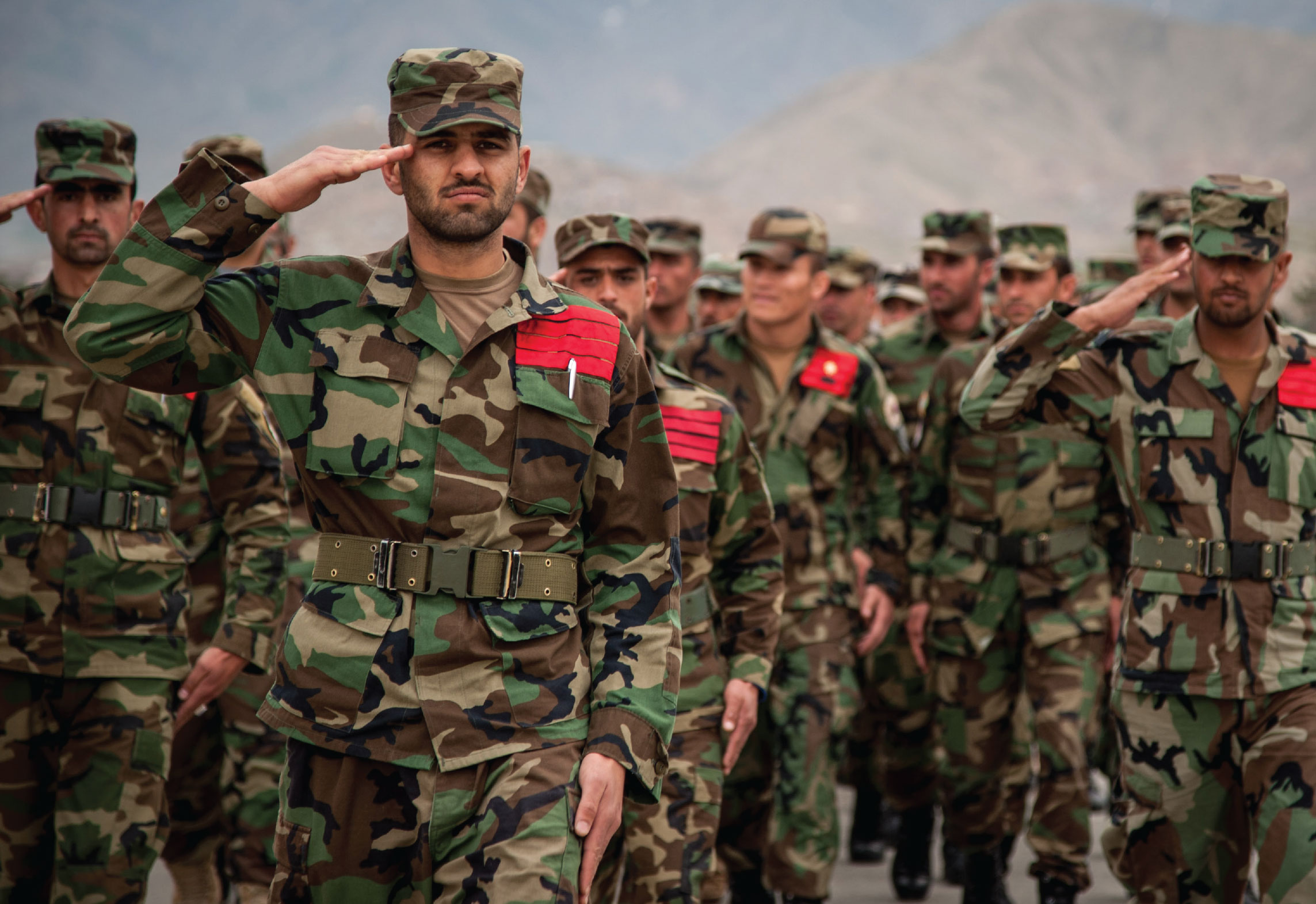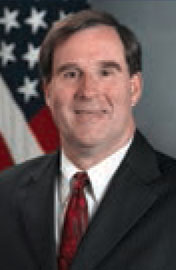Five Things We Can Still Get Right
Effective U.S. leadership is more important than ever in Afghanistan. What policies should we adopt to help as Afghans take the reins of their own country?
BY DAVID SEDNEY

Afghanistan has changed profoundly since the United States went into that country in the fall of 2001. We have kept the country from being used again as a base to launch attacks on the United States, and made a decent start on building a new, professional Afghan Army. In addition, Afghans are much better off today in many sectors, ranging from health and education to women’s and children’s rights.
Still, our overall record is mixed, and a great deal remains to be done. We have built roads that are falling apart, set up schools without teachers and failed to help Afghans build institutions of good governance. We have enriched some of the country’s most corrupt actors through poor contracting practices; failed to deliver progress in such key security sectors as air power and intelligence; and squandered our political capital on misguided efforts to get a secret bilateral deal with the Taliban (while ignoring the key internal political dynamics of Afghan society). And we have killed and humiliated far too many Afghans and damaged too much of their country in the pursuit of our counterterrorism policies.
Despite our mistakes and failures, however, we have much to be proud of and most Afghans still want us on the ground as partners. After a tense period, the millions of voters who surprised the world by their massive election turnout now have a reform government with a true mandate. Afghans take pride in their accomplishments on the world stage—like the soccer and cricket teams that have surged into prominence—and want to be part of the global community. For that to happen, though, Afghans themselves must take the lead.
The good news is that they are already doing so. Their soldiers and police are now fully responsible for fighting the Taliban, and are acquitting themselves well. Afghan women and young people are blazing new paths as they take advantage of their newfound access to education to build free and vigorous media and start new businesses across the country.
But for Afghanistan to achieve the kind of enduring success it deserves, the United States must continue to stand by our partner. As we have seen in Iraq, Libya and too many other places, when America stands aside—when we abandon what we started, and leave things half-done—the chances of failure increase dramatically and new, worse problems emerge. Pretending that the world will do what we want when we do not lead, and are not exemplars of our own values, is the definition of irresponsibility.
After a tense period, the millions of voters who surprised the world with their massive election turnout now have a reform government with a true mandate.
Immediate Challenges
The country’s new president, Ashraf Ghani Ahmadzai, has started off well. His post-election personal outreach to multiple sectors of society seeks to identify the government with the interests of the people, rather than as an instrument of power brokers. He has also recast Kabul’s relationship with the United States and NATO by living up to his campaign promise to sign security agreements that give the permissions necessary for the United States and NATO to assist Afghanistan’s security forces beyond 2014. And he is moving rapidly to shore up Afghanistan’s finances in anticipation of a potentially destabilizing revenue crunch.
Still, the new government faces severe, immediate challenges. Security throughout the country faces growing threats as a messy, too-rapid pullback of international forces is leaving major gaps. Both the Afghan military and civilians continue to suffer high casualties, and the Taliban is preparing to carry out a major military offensive next year. (Sadly, the agreements President Ghani signed allow the U.S. and NATO to help, but actually promise nothing concrete in terms of troops or assistance.)
The Afghan economy is still reeling from the drop-off in foreign investment that followed President Barack Obama’s “zero option” announcement last spring, exacerbated by post-election tensions. The Afghan people need jobs; economic growth requires capital investment; and current assistance models are not sufficiently focused and effective.
Recent events in Pakistan have strengthened the position of military hardliners there, who see the Afghan Taliban as a useful geopolitical tool to counter India and are hostile to the development of a strong, successful Afghanistan. The United States has placed too much faith in empty rhetoric from Islamabad, and failed to respond to actions that have strengthened the Afghan Taliban’s safe havens in Pakistan.
Finally, as in the rest of the Islamic world, the rise of the Islamic State group in Syria and Iraq has injected a major new dynamic that no one was prepared for, least of all a fragile Afghanistan. The extremists’ message is attracting some young Afghan males, and the group is reaching out to the Taliban to seek a union under the banner of establishing an anti-Western caliphate.
Casey Garret Johnson
The Path Ahead
So how should the United States lead in Afghanistan? What policies should we adopt to help the Afghans as they seize the reins of their own country? And how can we correct errors that we have made and ensure history sees America as the kind of country we know it should be? Here are five recommendations.
1. Make a clear, long-term political commitment to the Afghan people that allows for conditions-based Thexibility in our current withdrawal timelines.
Already, neighboring states, the Taliban and other actors are ramping up efforts to fill the vacuum we have created. As a result, the security situation is getting worse and, as documented by the United Nations Assistance Mission in Afghanistan, more people are dying. By adjusting the United States’ current timetable for withdrawing its forces—a timeline set to satisfy U.S. political concerns, without an evaluation of the effects on the ground—we can change everyone’s strategic calculus.
Shifting from a timeline-based approach to a conditions-based approach would also have a huge positive economic impact, giving those making investment and assistance decisions greater confidence in the country’s future.
2. Revise our approach to assisting the Afghan Security Forces to ensure that they acquire and maintain the kinds of capabilities they need today and into the future.
Already, neighboring states, the Taliban and other actors are ramping up efforts to fill the vacuum we have created.
This will require us to address the dangerous weaknesses in air power, intelligence, logistics and institutional and leadership development built into our current plans. For example, the Afghan Air Force needs fixed-wing transport and close air support aircraft, as well as transport and attack helicopters. For the decade or so it will take to develop these capabilities, or until the Taliban insurgency ends, we should continue to help provide those assets.
Afghanistan also needs a continuation of the robust intelligence support that has made our military efforts so effective. I visited the country this fall as we pulled down the tremendously capable aerostats that protected Kabul and most major population centers. These and other technical capabilities were huge multipliers for the Afghans’ excellent human intelligence, and played a major role in ensuring that the Taliban did not disrupt the elections.
With these capabilities gone, Taliban attacks will become more lethal and have greater reach into Afghan cities. This is already happening. But with a minor adjustment of our force levels, we could give Afghans time to acquire the necessary expertise to operate these systems themselves—something they are eager to do.
Weaknesses in logistics, institutional development and leadership are the Achilles’ heel of the Afghan forces now fighting bravely and successfully to defend their country. These weaknesses will not lead to a near-term dissolution of the Afghan military; we have done a good enough job for the Afghan forces to survive for at least several years. But our original plans never envisioned a complete U.S. pullout by 2016, as is now projected, and did not account for the continued strong support the Taliban is getting from inside Pakistan.
Over the longer term, without our technical assistance and support, the Afghan Security Forces will deteriorate from an effective national defense force into fragmented, abusive units that threaten the success of everything the Afghan people have achieved. Toward that end, we should carry out an immediate review to identify what capabilities and equipment Afghan forces need for the actual threats they will face in coming years.
Afghanistan also needs a continuation of the robust intelligence support that has made our military efforts so effective.
3. Change the way we provide assistance to Afghanistan to focus on direct aid to Afghan institutions.
Pres. Ghani, who has worked at the World Bank and was the first post-Taliban finance minister of Afghanistan, is intimately familiar with the way international assistance has traditionally been delivered and the problems created when it is done the wrong way. His 2008 book (co-authored with Clare Lockhart), Fixing Failed States: A Framework for Rebuilding a Fractured World, explains that giving aid directly to foreign governments, even taking into account corruption and other risks, is often more effective than funneling it through expensive third-party organizations. In most cases, nongovernmental organizations excel at delivering material and issuing reports, but do not foster the local institutional capacities necessary to work assistance givers out of their jobs.
We need to consult and cooperate with Pres. Ghani’s government to put these lessons into practice. This will be hard and will require cooperation from our Congress and our bureaucracies in ways they have not done before. But we have a historic opportunity to make our aid truly effective.
4. Develop mechanisms to right the wrongs we inThicted in the name of counterterrorism.
Particularly during our early years in Afghanistan, when our strategy centered on bombing and conducting “in-and-out” special forces raids, we routinely killed noncombatants; needlessly injured, imprisoned and humiliated many Afghans; and damaged homes, businesses and the very fabric of society in ways we still don’t understand very well.

Afghan National Army commandos stand in formation during the graduation of the ANA’s 7th Commando Kandak on Jan. 21. The commandos were trained by Afghan instructors and mentored by U.S., French, Canadian, Jordanian and United Arab Emirates special operations forces to provide a rapidly deployable light infantry unit to the Afghan National Security Force.
ISAF Joint Command / U.S. Air Force Staff Sgt. Logan Tuttle
More recently, especially when General Stanley McChrystal was in command there, we reversed many of these practices and put the Afghan people first. Yet even when we finally began making some restitution to Afghan civilians after raids, our payments were erratic and often never reached those who were most damaged. As a result, those families would often go over to the Taliban and become our enemies.
This is a difficult area that runs right up against hard-and-fast legal principles that underpin the American way of war and our interpretation of the international law of armed conflict. But the fact remains that for many Afghans, American actions not only did not make them safer; they made them more vulnerable.
It is not too late for us to rethink our approach and rectify these injustices. True, doing so will require legislative action, which would undoubtedly spawn strong opposition from many quarters. But if the American experience in Afghanistan is to live up to what we claimed—that we are not like other foreign powers who came only for their own ends—then it is a task we should undertake, both for the Afghan people and for ourselves.
5. Undertake a serious effiort to educate the American people about the reality of Afghanistan and what we have achieved there.
None of the above will be possible without the support of the American people. Sadly, today’s polls show most Americans believe we were wrong to go into Afghanistan in the first place. But not too long ago, the answer was the opposite.
We have a historic opportunity to make our aid truly effective.
What changed? Is it war weariness, as so many armchair pundits opine? Or is it something more? In my discussions with a range of Americans over the past year, I have found a different answer: Americans are “failure weary.” They see Afghanistan and Iraq as similar failed efforts, where violence and depravity are the norm. They do not understand what has really happened on the ground in Afghanistan.
Nor do most Americans understand what we undertook there. They see a failure of “nation-building”—notwithstanding the fact that both President George W. Bush and President Obama explicitly rejected “nation-building” as a goal, and never devoted enough resources to get anywhere close to achieving it. Some go so far as to assert that we have failed by not defeating the Taliban, even though Pres. Obama specifically disavowed that goal when he announced the 2009 “surge.” Instead, he declared that our aim was to degrade the Taliban, so that the Afghan Security Forces could handle the threat it still poses, with some help from us.
When I and others in the administration wanted to use the word “win” in documents, we were told not to by White House officials who insisted that our objective was limited to degrading, not winning. Somewhat understandably, most Americans never understood that distinction.
The explanations for Americans’ astonishing ignorance about Afghanistan are many, starting with a media fixated on violence, failure and scandal that also suffers from a kind of “groupthink” that makes it unfriendly to stories that challenge the prevailing narrative. Perhaps most important, however, is the lack of leadership on Afghanistan from the very top—across two administrations. Whatever the reasons, we need to come up with an approach that delivers accurate information to the American people early on, so they can decide on the basis of facts, not armchair opinions.
We can start by inviting many more Afghans to visit and study in our country to deliver that message. Only a handful of Americans know about the bustling streets of Herat and Kabul, or the major advances being wrought by a new generation of educated young Afghans. They have never heard of Afghan software entrepreneurs, artists and scientists. But when Americans meet Afghans, particularly young people and women, and learn the reality of their country, their views change.
The explanations for Americans’ astonishing ignorance about Afghanistan are many.
Finally, the dedicated diplomatic and development professionals of the Foreign Service who have served in Afghanistan should be traveling all over our country to tell people what they have seen firsthand there: a country that, despite massive problems and huge challenges, has made immense progress, and wants to be our partner and ally. They can make the case that Afghans appreciate the sacrifices Americans have made on their behalf, and will be on our side for generations to come if we reorient our policies toward success—for both of our nations.
Larger Goals
Fulfilling our repeated statements of commitment to continue supporting the Afghan people, particularly women, will help us achieve larger goals: namely, ensuring that Afghanistan does not return to the chaotic conditions that allowed al-Qaida to attack our country on Sept. 11, 2001, and stabilizing a region where extremism, nationalism, nuclear weapons and terrorism are a volatile mix that could reach out to threaten us in new ways.
These goals mesh with the kind of future the Afghan people voted for, and which the new government of President Ghani and Chief Executive Officer Abdullah Abdullah seeks to bring about.
In helping to achieve them, we will prove to the world (and ourselves) that when America undertakes a mission, we not only accomplish it, but do so in a manner that lives up to our fundamental values.
Read More...
- NATO Secretary General welcomes signing of security agreements with Afghanistan (NATO)
- US Troops to Leave Afghanistan by End of 2016 (New York Times)
- Ashraf Ghani: From the World Bank to Afghanistan’s next president? (The Telegraph)
- Stanley McChrystal: Listen, learn… then lead (TED Talks)
- More Now See Failure than Success in Iraq, Afghanistan (Pew Research)


